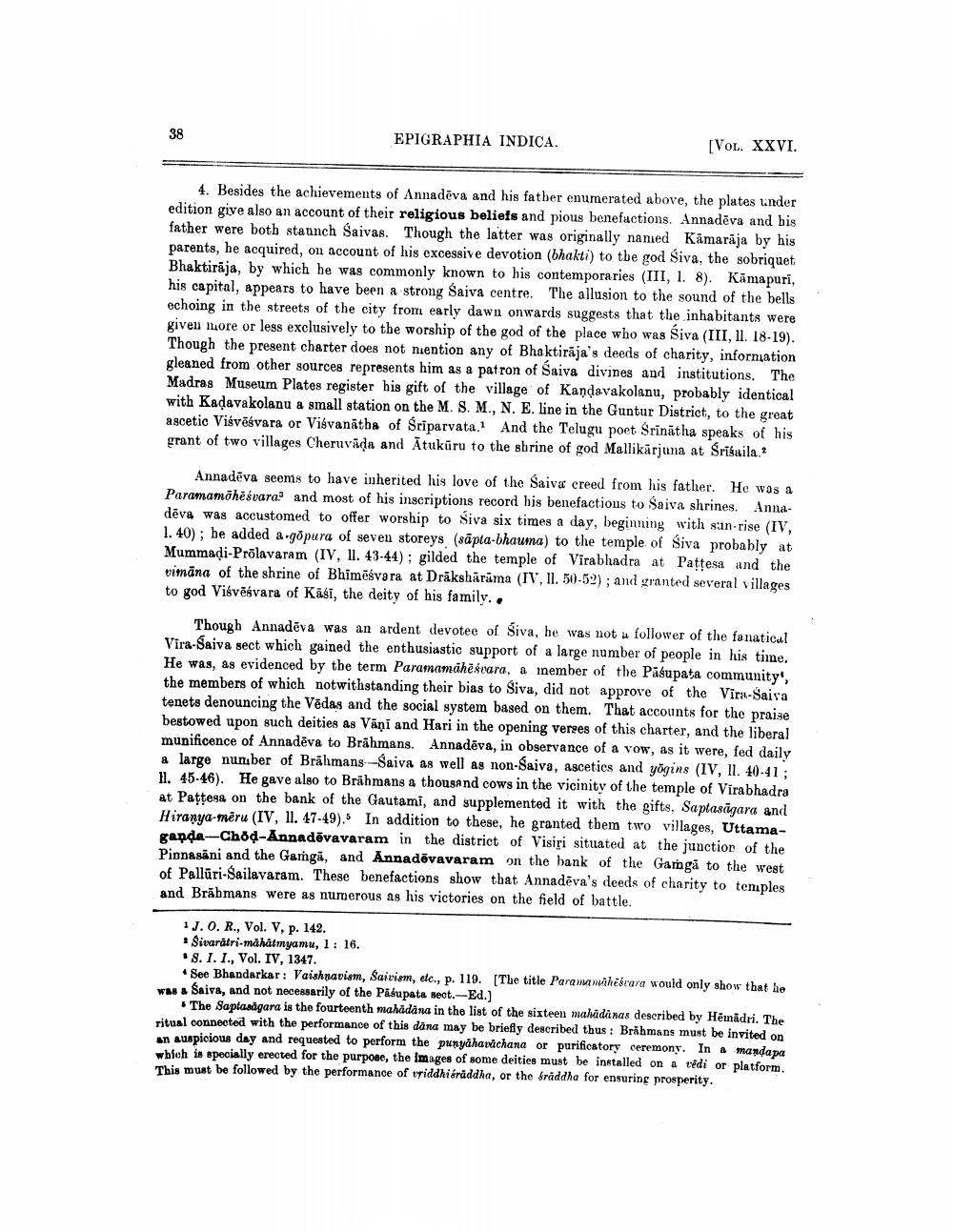________________
38
EPIGRAPHIA INDICA.
[VOL. XXVI.
4. Besides the achievements of Annadeva and his father enumerated above, the plates under edition give also an account of their religious beliefs and pious benefactions. Annadeva and his father were both staunch Saivas. Though the latter was originally named Kamaraja by his parents, he acquired, on account of his excessive devotion (bhakti) to the god Śiva, the sobriquet. Bhaktiraja, by which he was commonly known to his contemporaries (III, 1. 8). Kāmapuri, his capital, appears to have been a strong Saiva centre. The allusion to the sound of the bells echoing in the streets of the city from early dawn onwards suggests that the inhabitants were given more or less exclusively to the worship of the god of the place who was Šiva (III, 11. 18-19). Though the present charter does not mention any of Bhaktiraja's deeds of charity, information gleaned from other sources represents him as a patron of Saiva divines and institutions. The Madras Museum Plates register his gift of the village of Kandavakolanu, probably identical with Kaḍavakolanu a small station on the M. S. M., N. E. line in the Guntur District, to the great ascetic Visvesvara or Viśvanatha of Śriparvata. And the Telugu poet Srinatha speaks of his grant of two villages Cheruvada and Atukuru to the shrine of god Mallikarjuna at Srisaila.?
Annadeva seems to have inherited his love of the Saiva creed from his father. He was a Paramamohēsvara and most of his inscriptions record his benefactions to Saiva shrines. Annadeva was accustomed to offer worship to Siva six times a day, beginning with san-rise (IV, 1. 40); he added a-gopura of seven storeys (sapta-bhauma) to the temple of Siva probably at Mummadi-Prōlavaram (IV, ll. 43-44); gilded the temple of Virabhadra at Pattesa and the vimana of the shrine of Bhimesvara at Draksharama (IV, 11. 50-52); and granted several villages to god Visvesvara of Käsi, the deity of his family..
1 J. O. R., Vol. V, p. 142.
1 Sivaratri-mahatmyamu, 1: 16.
Though Annadeva was an ardent devotee of Siva, he was not a follower of the fanatical Vira-Saiva sect which gained the enthusiastic support of a large number of people in his time. He was, as evidenced by the term Paramamahesvara, a member of the Pasupata community', the members of which notwithstanding their bias to Siva, did not approve of the Vira-Saiva tenets denouncing the Vedas and the social system based on them. That accounts for the praise bestowed upon such deities as Vāņi and Hari in the opening verses of this charter, and the liberal munificence of Annadeva to Brahmans. Annadeva, in observance of a vow, as it were, fed daily a large number of Brahmans-Saiva as well as non-Saiva, ascetics and yogins (IV, 11. 40-41; H. 45-46). He gave also to Brähmans a thousand cows in the vicinity of the temple of Virabhadra at Pattesa on the bank of the Gautami, and supplemented it with the gifts. Saptasagara and Hiranya-mēru (IV, 11. 47-49). In addition to these, he granted them two villages, Uttamaganda-Chod-Annadēvavaram in the district of Visiri situated at the junction of the Pinnasäni and the Gamga, and Annadēvavaram on the bank of the Gamga to the west of Palluri-Sailavaram. These benefactions show that Annadeva's deeds of charity to temples and Brahmans were as numerous as his victories on the field of battle.
8. I. I., Vol. IV, 1347.
See Bhandarkar: Vaishnavism, Saivism, etc., p. 119. [The title Paramamahebrara would only show that he was a Saiva, and not necessarily of the Pasupata sect.-Ed.]
The Saptasagara is the fourteenth mahadana in the list of the sixteen mahadanas described by Hemadri. The ritual connected with the performance of this dana may be briefly described thus: Brahmans must be invited on an auspicious day and requested to perform the punyähavachana or purificatory ceremony. In a mandapa which is specially erected for the purpose, the images of some deities must be installed on a vedi or platform. This must be followed by the performance of vriddhiéräddha, or the braddha for ensuring prosperity.




